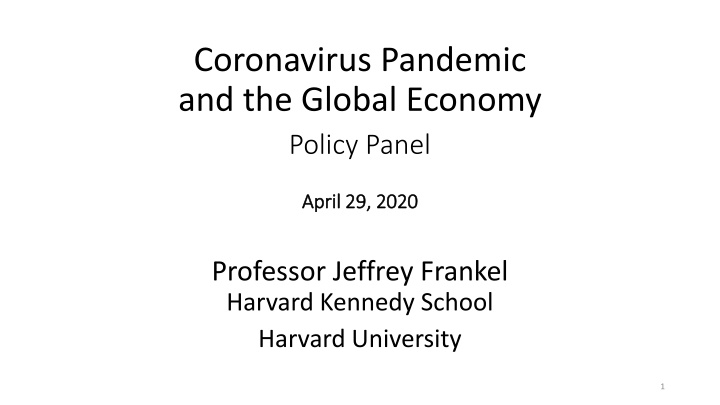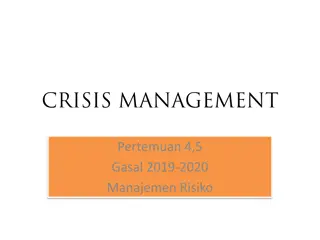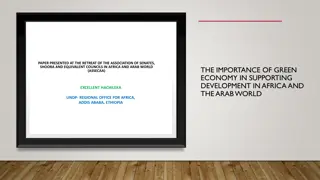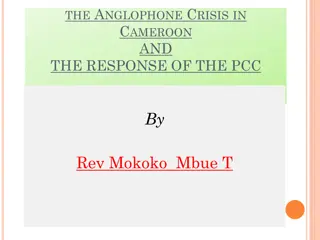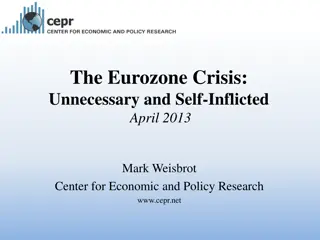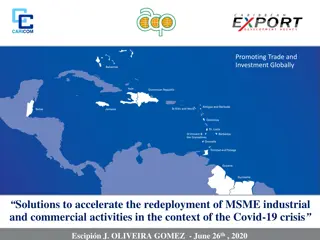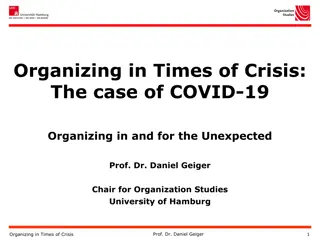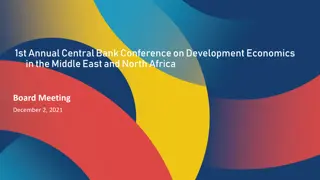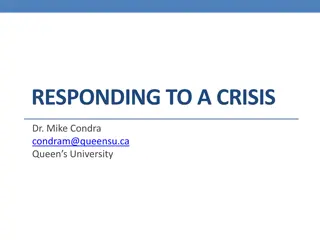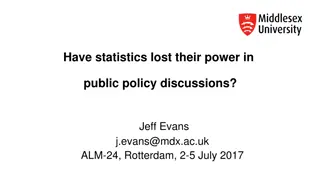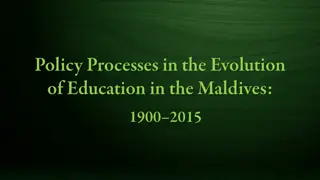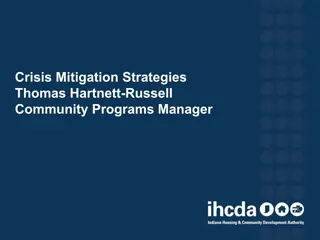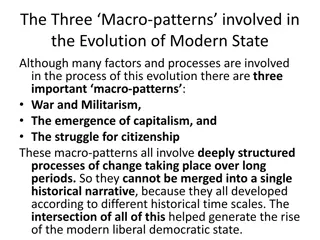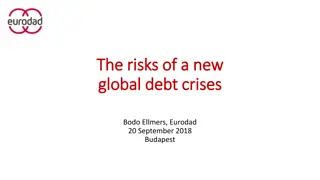Global Economy in Crisis: Historical Perspective and Policy Responses
The severity of the current crisis surpasses recent pandemics and global recessions, resembling historical events like the 1918-19 influenza pandemic and the 1930s Great Depression. This article delves into the rapid sequence of events in 2020, encompassing the WHO declaration, financial market turmoil, oil price collapse, and the ensuing recession. It also highlights the policy responses by governments and the challenges faced globally, particularly the impact of COVID-19 on health systems, commodity prices, and international markets.
Download Presentation

Please find below an Image/Link to download the presentation.
The content on the website is provided AS IS for your information and personal use only. It may not be sold, licensed, or shared on other websites without obtaining consent from the author.If you encounter any issues during the download, it is possible that the publisher has removed the file from their server.
You are allowed to download the files provided on this website for personal or commercial use, subject to the condition that they are used lawfully. All files are the property of their respective owners.
The content on the website is provided AS IS for your information and personal use only. It may not be sold, licensed, or shared on other websites without obtaining consent from the author.
E N D
Presentation Transcript
Coronavirus Pandemic and the Global Economy Policy Panel April 29, April 29, 2020 2020 Professor Jeffrey Frankel Harvard Kennedy School Harvard University 1
Outline I. Historical severity of the crisis II. The rapid sequence of events so far III. Policy response by governments IV. Baseline forecast of economic growth V. Shape of the recovery: V , U , or W ? 2
I. Historical severity of the crisis I. Historical severity of the crisis The developments of 2020 are much worse, even, than pandemics like the H1N1 virus of 2009 ( Swine flu ) or recessions like the 2007-09 Global Financial Crisis. For adequate precedents we have to go back to the first half of the 20th century: the global influenza pandemic of 1918-19 and the Great Depression of the 1930s. 3
II. The rapid sequence of events so far II. The rapid sequence of events so far 1. Jan. 30: WHO declares Public Health Emergency. Virus spreads to successive countries. 2. Feb. 24: Risk off in global financial markets. 3. Feb. 26: Collapse in oil price. 4. March: Recession starts. 4
1. Reported deaths peaked in China. Then Italy. UK & US may be next. https://www.ft.com/coronavirus-latest Note: Excess mortality in 14 countries runs about 60% above reported Covid19 death tolls. www.ft.com/content/6bd88b7d-3386-4543-b2e9-0d5c6fac846c5
2. Risk off in global financial markets Perceived risk, as measured by the VIX (CBOE Volatility Index) was below 14.0 as late as Feb. 14, but then rose, to 70 in mid-March. => Investors turned risk-averse: pulled out of equites (Feb. 24), then corporate bonds (esp. junk bonds & EM securities, March 10). They moved into safe-haven currencies, particularly the US $, which on March 23 reached its highest value since 2002. 6
3. Collapse of oil prices started February 26. On April 20, price of WTI < 0. The losers: Middle East & Russia and some in Latin America & Africa. WTI Crude Oil Price, Macrotrends, April 24, 2020 For many developing countries, a fall in commodity export prices comes on top of: a sudden stop to capital inflows, declining remittances, and the terrible challenges of Covid-19 itself spreading to countries with health care systems that are inadequate even at the best of times. 7
4. It is rare that one can predict recession before the numbers are in. But not this time. Most countries are in recession. (IMF baseline forecast) 8 IMF WEO, April 2020, Figure 1.5. World Growth in GDP per Capita and Recession
III. Policy response by governments III. Policy response by governments 1. In most countries, officials did not take Covid-19 seriously enough, especially those with insufficient awareness of past history of pandemics. China released the genetic code for the new coronavirus in early January. But countries like the US & UK did not use the time to prepare. They should have launched testing campaigns & ordered equipment. E.g.., U.S. President, Feb. 26: when you have 15 people, and the 15 within a couple of days is going to be down to close to zero, that s a pretty good job we ve done. 9
2. By now, however, most countries have responded with: public health measures and appropriate macroeconomic stimulus: fiscal relief & stimulus measures (in US, March 27) and monetary expansion going even beyond the Unconventional Monetary Policies of 2008-09. 10
IV. Forecast of GDP growth: Forecast of GDP growth: IMF s World Economic Outlook, April 14 lowered its forecast for global growth in 2020 sharply, by 6.3% pts. from the January forecast, to an unprecedented 3.0% worldwide. That averages -1.0 % in EM & developing countries and -6.1% in advanced economies (expected mostly in Q2) including -5.9% in US 2020 GDP. US Q1 BEA reported this a.m.: a fall of 4.8% q/q, per annum. US Q2 almost -40%, q/q compounded per annum. IMF s base case is probably still too optimistic, due to downside risks. 11
April 29, US BEA announced GDP fell 4.8% in Q1 (q-o-q, p.a.) 12
The IMF base case is a 2020 recession much worse than 2008. 13 IMF World Economic Outlook, April 2020
Even EM & Developing Economies show negative growth. 14 IMF World Economic Outlook, April 2020
V. What shape of recovery: V, U, or W? shape of recovery: V , U , or W ? 1. V-shaped recovery in the global economy is not likely. At first, V bounce-backs seemed plausible. Natural disasters usually follow that pattern. E.g., China s 2003 SARS is estimated to have cost 2% growth in Q2, but didn t show up in the year s overall GDP. Indeed, China itself reports that Industrial Production bounced back in March 2020 from its February plunge. But a V is too optimistic, for the aggregate world economy. 15
2. More likely, at best, is a U-shaped recovery: 60% of business leaders expect U shape -- World Ec. Forum, April 24. Certain segments of the economy go back to work, while others remain shut down longer at least until we achieve massive, frequent, convenient, free testing + contact-tracing + reliable tests for anti-bodies; and perhaps even until a vaccine is available, which we are told will take 1 years at best, or an effective treatment. 16
3. I worry about a W I worry about a W- -shaped recovery, arising from policy mistakes. shaped recovery, arising from policy mistakes. Two possible mistakes are illustrated by events of the inter-war period. Mistake #1: Leaders sound the all-clear signal on contagion too soon. Some politicians have shown an excessive bias towards optimism. This over-optimism has already done harm by delaying action. It can do more harm if they try to re-open the economy prematurely. The 1918-19 global influenza pandemic is an informative precedent. American cities instituted public health interventions in 1918. Those cities that let up early suffered a 2nd or 3rd wave of flu, with more deaths. 17
Mistake #2: Abandoning economic stimulus too soon, resulting in a renewed downturn. The best precedent in the US is 1936-37. Roosevelt prematurely tightened fiscal policy. The Fed too tightened in 1936. As a result, the US went back into severe recession in 1937-38. This could easily happen again in 2021. Conclusion: A W-shaped pattern, i.e., relapses in health & the economy, could result from early withdrawal either of public health measures or of economic stimulus. 18
Coronavirus Pandemic and the Global Economy Policy Panel Professor Jeffrey Frankel Harvard University 19
Appendix graphs Effects on: Financial markets Commodity prices International trade 20
Investors shifted out of corporate bonds & equities. IMF WEO, April 2020. Figure 1.2. Advanced Economies: Monetary and Financial Market Conditions 21
Investors pulled out of Emerging Market bonds. (EMBI Sovereign Spreads, basis points) IMF WEO, April 2020. 22
Investors pulled out of Emerging Market equities. (Jan.1, 2019 = 100) 23 IMF WEO, April 2020. Figure 1.3.
Impact of the Covid-19 outbreak on oil & commodity prices % % 24 IMF WEO, April 2020. Figure 1.SF.1
Trade is falling even more sharply than GDP. IMF World Economic Outlook, April 2020 25
